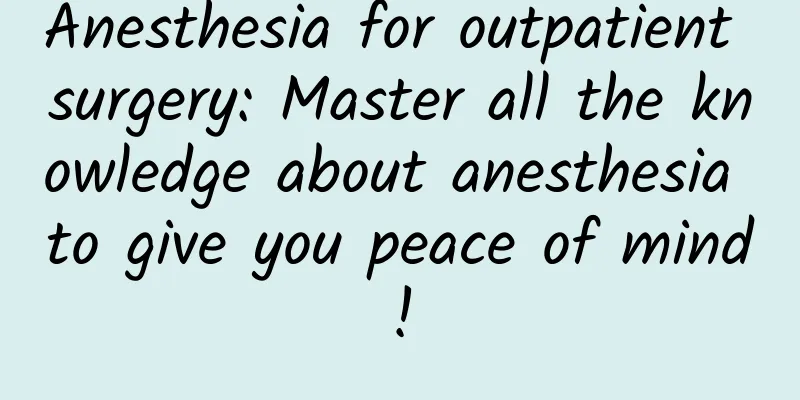Anesthesia for outpatient surgery: Master all the knowledge about anesthesia to give you peace of mind!

|
Outpatient surgery is currently widely performed in various hospitals. Some short minor surgeries and examinations can be performed in the outpatient operating room. It is simple and convenient. Patients can see a doctor, undergo surgery on the same day, and go home on the same day, bringing convenience and a good medical experience to patients. As people pay more and more attention to their own health, they tend to prefer comfortable medical treatment during medical treatment. For those who are afraid of pain and cannot cooperate with the examination, painless anesthesia can avoid iatrogenic mechanical damage caused by the patient's non-cooperation, improve the negative effects of changes in blood pressure, heart rate, etc. caused by nerve stimulation, and there are no serious adverse sequelae after waking up. Occasionally, there are mild discomforts such as nausea, vomiting, dizziness, and drowsiness, which can completely disappear on the same day. Therefore, painless technology has gradually penetrated into outpatient diagnosis and treatment. Image source: Pixabay What is painless anesthesia? It means that after the intravenous line is established, intravenous anesthetic drugs are given, so that the patient can complete the examination or operation in a painless state, and can go through the whole process in a "dream", no longer full of fear and tension. Anesthetic drugs are short-acting preparations, and the duration is relatively short. It depends on the time required for the operation, usually a few minutes to ten minutes. After the examination, the patient can wake up quickly. Which patients can choose painless anesthesia? Patients who are afraid of outpatient surgery or examinations, have a need for comfortable treatment, and have no contraindications to anesthesia can all undergo painless anesthesia to improve their medical experience. Precautions before outpatient painless anesthesia ★1. Do not eat or drink on the day of surgery/anesthesia (starting from 0:00 on the day of surgery). ★2. A responsible adult must accompany the patient on the day of surgery. ★3. No makeup, nail polish, jewelry, or contact lenses, and wear loose, easy-to-remove clothes. ★4. The patient should truthfully inform the doctor of past medical history, such as allergy history, medication history, surgical history, systemic disease history, etc., so that the anesthesiologist can make a comprehensive assessment. ★5. Outpatient painless anesthesia is not recommended for patients with asthma, epilepsy, mental illness, heart disease and other diseases. To ensure your safety, you need to complete relevant examinations after hospitalization and perform it in an operating room with better rescue conditions. If you have a cold, cough, or fever, please inform the truth and anesthesia can only be performed after recovery. ★6. The patient must be fully conscious and accompanied by an adult with full responsibility before leaving the hospital. The patient must understand the requirements for activities after leaving the hospital and must be accompanied by an adult within 24 hours. In special cases, it is recommended to stay in the hospital for observation. ★7. Within 24 hours, you are not allowed to drive any type of motor vehicle or non-motor vehicle, operate dangerous machines or instruments, or engage in other high-risk operations (such as electrical work, high-altitude operations, etc.); you are not allowed to make important decisions. ★8. After fully waking up from anesthesia, start eating a small amount of light liquid food and gradually increase the amount. ★9. Most postoperative symptoms (such as nausea, vomiting, dizziness, headache, etc.) will disappear within 24 hours. Please follow up promptly if symptoms persist or if there are changes in the condition. Source: Chongqing Institute of Population and Family Planning Science and Technology Author: Wan Linling, Department of Anesthesiology, Affiliated Hospital of Chongqing Family Planning Research Institute Audit expert: Chen Liang Statement: Except for original content and special notes, some pictures are from the Internet. They are not for commercial purposes and are only used as popular science materials. The copyright belongs to the original authors. If there is any infringement, please contact us to delete them. |
<<: What is arrhythmia? What are the solutions for arrhythmia?
>>: How to prevent osteoporosis in middle-aged and elderly people through diet therapy
Recommend
Advantages of fallopian tube wire unblocking
Infertility brings harm to many families. Some fa...
How to choose beef? Beef fat content
Beef is rich in protein and amino acids, and its ...
What are the ingredients for deep-fried skewers? What oil is used for deep-fried skewers?
Fried skewers are made by deep-frying a lot of me...
What to do if itching in the vagina
Vulvar itching is a very common gynecological dis...
What are the symptoms of anemia in women? How to regulate?
Anemia is a symptom that most women have, but the...
Can adenomyosis heal itself? 3 Things You Must Know
Adenomyosis is a common disease in bed, which can...
Causes of acne caused by makeup
After putting on makeup every morning, female fri...
Can pregnant women eat pumpkin vines and what are the precautions
Pumpkin vines are very delicious. We all know tha...
The steamed buns are cracked. Is it good or bad to steam them? What's the matter with the steamed buns?
Steamed buns are a common type of pasta. They are...
If there is a stroke patient at home, how to provide home rehabilitation care correctly?
Stroke is a disease with a high incidence rate in...
Don't joke about depression, it's a disease and needs to be treated.
Have you listened to Internet Depression today? N...
What is the reason for a woman's face to turn red
It is said that complexion reflects a person'...
Can breast fibroids be cured?
From the perspective of clinical incidence, breas...
What are the rules for eating mooncakes during the Mid-Autumn Festival? Who should eat less mooncakes?
The Mid-Autumn Festival is coming, and mooncakes ...









